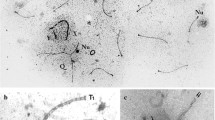Abstract
Pairing of homologous chromosomes results in the formation of 34 synaptonemal complexes (SC) at pachytene, corresponding to the 34 bivalents at metaphase I. No multivalent associations were observed and pairing occurs two-by-two. The modified SC, which lacks a central element, does not affect the pairing process. Only one end of the SC is attached to the nuclear envelope, although either end can attach. Total SC length and the number of recombination nodules in the tetraploid were about 1.5 times greater than in the diploid.
Similar content being viewed by others
References
Braten, T., Nordby, O.: Ultrastructure of meiosis and centriole behavior in Ulva mutabilis. J. Cell Sci. 13, 69–81 (1973)
Gillies, C.B.: Synaptonemal complex and chromosome structure. Ann. Rev. Genet. 9, 91–109 (1975)
Goldstein, P.: Spermatogenesis and spermiogenesis in Ascaris suum. J. Morph. 154, 317–338 (1977)
Goldstein, P., Moens, P.B.: Karyotype analysis of Ascaris lumbricoides var. suum male and female pachytene nuclei by 3-D reconstruction from electron microscopy of serial sections. Chromosoma (Berl.) 58, 101–111 (1976)
Goldstein, P., Triantaphyllou, A.C.: Occurrence of synaptonemal complexes and recombination nodules in a meiotic race of Meloidogyne hapla and their absence in a mitotic race. Chromosoma (Berl.) 68, 91–100 (1978a)
Goldstein, P., Triantaphyllou, A.C.: Karyotype analysis of Meloidogyne hapla by 3-D reconstruction of synaptonemal complexes from electron microscopy of serial sections. Chromosoma (Berl.) 70, 131–139 (1978b)
Goldstein, P., Triantaphyllou, A.C.: Karyotype analysis of the plant-parasitic nematode Heterodera glycines by electron microscopy. I. The diploid. J Cell Sci. 40, 171–179 (1979)
Goldstein, P., Triantaphyllou, A.C.: Karyotype analysis of the plant parasitic nematode Heterodera glycines by electron microscopy. II. The tetraploid and an aneuploid hybrid. J. Cell Sci. 43, 225–237 (1980)
Moens, P.B.: Ultrastructural studies of chiasma distribution. Ann. Rev. Genet. 12, 433–450 (1978)
Rasmussen, S.W.: The meiotic prophase in Bombyx mori females analysed by three-dimensional reconstructions of synaptonemal complexes. Chromosoma (Berl.) 54, 245–293 (1976)
Rasmussen, S.W., Holm, P.B.: Chromosome pairing in autotetraploid Bombyx females. Mechanism for exclusive bivalent formation. Carlsberg Res. Commun. 44, 101–125 (1979)
Storms, R., Hastings, P.J.: A fine structure analysis of meiotic pairing in Chlamydomonas reinhardii. Exp. Cell Res. 104, 39–46 (1977)
Triantaphyllou, A.C.: Polyploidy and reproductive patterns in the root-knot nematode Meloidogyne hapla. J. Morph. 118, 404–414 (1966)
Triantaphyllou, A.C., Hirschmann, H.: Cytogenetics and morphology in relation to evolution and speciation of plant-parasitic nematodes. Ann. Rev. Phytopath. 18, 333–359
Westergaard, M., Wettstein, D. von: The synaptinemal complex. Ann. Rev. Genet. 6, 71–100 (1972)
Author information
Authors and Affiliations
Rights and permissions
About this article
Cite this article
Goldstein, P., Triantaphyllou, A.C. Pachytene karyotype analysis of tetraploid Meloidogyne hapla females by electron microscopy. Chromosoma 84, 405–412 (1981). https://doi.org/10.1007/BF00286029
Received:
Issue Date:
DOI: https://doi.org/10.1007/BF00286029



